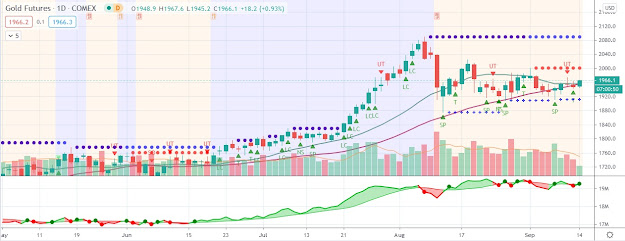Analysts at UBS also offered a constructive stance on the gold price
The gold price stabilized near $1,600 per ounce on Thursday as financial
markets digested the outcome of the European Central Bank’s (ECB)
meeting and press conference. The price of gold
initially fell toward $1,590 following the ECB’s decision to not launch
any new stimulus measures. However, the gold price later bounced back
to $1,600 as ECB President Mario Draghi stated that the central bank
stands ready to buy Spanish and Italian bonds, although no immediate
action was undertaken.
The lack of action by the ECB mirrored that of the Federal Reserve yesterday, which did launch a third round of quantitative easing (QE3) or any other new monetary stimulus programs. The Ben Bernanke-led central bank did present a more dovish tone in its statement, however, noting that the outlook for the U.S. economy has worsened in recent months. Furthermore, the Fed noted that it “will provide additional accommodation as needed to promote a stronger economic recovery,” a noticeable change from the prior meeting where it vowed to “take further action as appropriate to promote a stronger economic recovery.”
As for the gold price, while it has given back approximately half of last week’s 2.5% rally, it has successfully held the psychologically-important $1,600 level on numerous occasions this week. Looking ahead, the next likely catalyst for the price of gold is tomorrow’s U.S. employment report, where the median forecast among economists is for non-farm payrolls to have risen by 100,000 in July.
James Steel, a precious metals analyst at HSBC, commented that “Although gold may stay on the defensive near term, we believe any further weakness is likely to be short-lived, as investors may shift focus to the next [Federal Open Market Committee] meeting in September.”
Analysts at UBS also offered a constructive stance on the gold price, noting that “Central bank activity is in part filling in for the tame retail physical buying from the likes of India of late by helping gold on the downside and inserting a price floor…In turn this has been providing investors with some comfort, that stronger hands are active sub $1,600, but importantly that their comfortable price entry is rising.”
The lack of action by the ECB mirrored that of the Federal Reserve yesterday, which did launch a third round of quantitative easing (QE3) or any other new monetary stimulus programs. The Ben Bernanke-led central bank did present a more dovish tone in its statement, however, noting that the outlook for the U.S. economy has worsened in recent months. Furthermore, the Fed noted that it “will provide additional accommodation as needed to promote a stronger economic recovery,” a noticeable change from the prior meeting where it vowed to “take further action as appropriate to promote a stronger economic recovery.”
As for the gold price, while it has given back approximately half of last week’s 2.5% rally, it has successfully held the psychologically-important $1,600 level on numerous occasions this week. Looking ahead, the next likely catalyst for the price of gold is tomorrow’s U.S. employment report, where the median forecast among economists is for non-farm payrolls to have risen by 100,000 in July.
James Steel, a precious metals analyst at HSBC, commented that “Although gold may stay on the defensive near term, we believe any further weakness is likely to be short-lived, as investors may shift focus to the next [Federal Open Market Committee] meeting in September.”
Analysts at UBS also offered a constructive stance on the gold price, noting that “Central bank activity is in part filling in for the tame retail physical buying from the likes of India of late by helping gold on the downside and inserting a price floor…In turn this has been providing investors with some comfort, that stronger hands are active sub $1,600, but importantly that their comfortable price entry is rising.”




Comments
Post a Comment